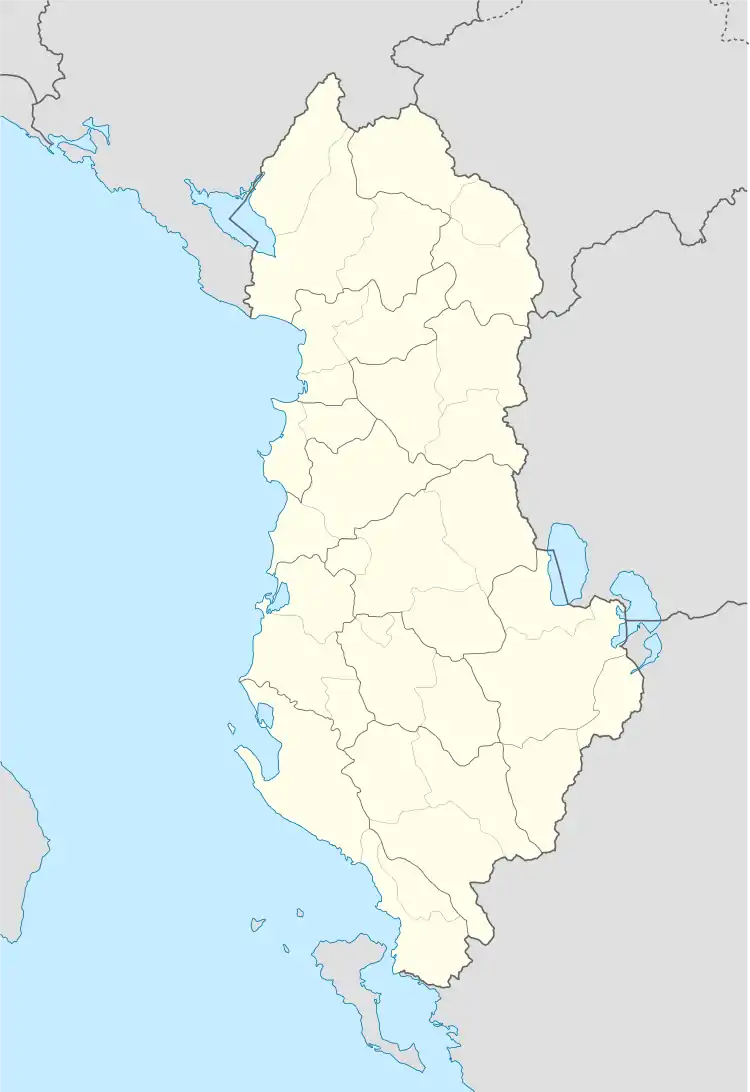Labovë e Madhe
Labova e Madhe is not to be confused by the nearby town Labova e Kryqit, in Libohovë municipality.
Labovë e Madhe
Μέγα Λάμποβο | |
|---|---|
 Labovë e Madhe | |
| Coordinates: 40°12′25″N 20°08′10″E | |
| Country | |
| County | Gjirokastër |
| Municipality | Gjirokastër |
| Municipal unit | Odrie |
| Time zone | UTC+1 (CET) |
| • Summer (DST) | UTC+2 (CEST) |
Labovë, alternatively Labova e Madhe[1] (Great Labova; Greek: Μέγα Λάμποβο) or Labova e Zhapës (Zappas' Labova), is a village in the former Odrie municipality, Gjirokastër County, Southern Albania. At the 2015 local government reform it became part of the municipality Gjirokastër.[2] It is situated roughly 650m above the sea level.
History
The village was home of the Greek entrepreneurs and national benefactors Evangelis Zappas and his cousin, Konstantinos Zappas. Because of their family name the town is alternatively called "Labovë e Zhapës" although officially it is still called Labovë. The Zappas sponsored the foundation of educational facilities known as Zappeian School (Ζάππεια Διδασκαλεία). In 1875-1876 this consisted of: a primary and a high school as well as a female, a weaving school for girls and a library containing 400 volumes from Greek and Latin authors.[3] Evangelis Zappas participated in 1860 in the debate about Albanian being written and held the view that the language could not become a literary one but should not be abandoned and that a Greek-based alphabet be used for Albanian in the Labovë school founded by him.[4][5]
At 1929 a proposal to re-establish a school for the Greek-speaking children of Labovë was dismissed by state officials, as according to their report the initiative had not been well received by local Albanian Christians.[6]
Demographics
During the Ottoman census of 1895, Labovë, a Greek-speaking village, counted 701 inhabitants.[7] The village of Labovë e Madhe is one of mixed speech (Albanian and Greek) which is inhabited by an Orthodox Albanian population that speaks Albanian as a mother tongue and Aromanians who form a significant community in the village.[8][9] The Aromanian presence in Labovë e Madhe dates to the 20th century when during the communist era of Albania they settled in the village.[10]
Notable people
- Aleksander Meksi prime minister of Albania
- Kristo Meksi, politician
- Vangjel Meksi, translator of the New Testament in Albanian
- Evangelis Zappas, benefactor
- Konstantinos Zappas, benefactor
- Petros Zappas, entrepreneur and politician
- Ghica family, Romanian noble family
References
- "Maps, Weather, and Airports for Labova e Madhe, Albania".
- Law nr. 115/2014 Archived 2015-09-24 at the Wayback Machine
- Sakellariou M. V.. Epirus, 4000 years of Greek history and civilization. Ekdotikē Athēnōn Archived 2010-06-14 at the Wayback Machine, 1997. ISBN 978-960-213-371-2, p. 308.
- Skoulidas, Elias (2013). "The Albanian Greek-Orthodox Intellectuals: Aspects of their Discourse between Albanian and Greek National Narratives (late 19th - early 20th centuries)". Hronos. 7. para. 16 "At the same period, two wealthy persons Evangelos Zappas, from Labova e Madhe/Mega Lambovo (with a letter to Elpis), and Hristaki Zografo from Qestorat/Kestorati, another village from Lunxhëri, proposed the use of an alphabet with Greek characters. To understand the mentalities, it wasn’t a problem for Hristaki Zografo to promote the teaching of the Albanian language at elementary or primary schools and at the same time to be the president of the Epirotic Syllogue (Ηπειρωτικός Σύλλογος) in Istanbul for the expansion of the Greek educational network in the Ottoman Empire."
- Clayer, Nathalie (2007). Aux origines du nationalisme albanais: La naissance d'une nation majoritairement musulmane en Europe [The origins of Albanian nationalism: The birth of a predominantly Muslim nation in Europe]. Paris: Karthala. ISBN 9782845868168. p. 201. "Evangelos Zappas (1800-1865) avait participé à la guerre d’indépendence, puis avait fait fortune en Roumanie. Il finança l’ouverture d’écoles, dans son village natal et dans d'autres locatités de l’Epire. En 1860, il participa à ce débat sur la littérarisation de la langue albanaise, qui se déroulait non seulement dans le journal de Pykaios, mais aussi dans l’Elpis, un périodique de la capital grecque. Dans une lettre adressée à ce journal, il estimait que la langue albanaise n’etait pas en mesure de devenir une langue littéraire, mais qu’elle ne devait pas être abandonnée. Il suggérait l’usage de l’alphabet, à base grecque, employeé dans l'ecole de Labovë fondée par ses soins."
- Hemming, Andreas; Kera, Gentiana; Pandelejmoni, Enriketa (2012). Albania: Family, Society and Culture in the 20th Century. LIT Verlag Münster. p. 102. ISBN 9783643501448.
- Μιχάλης, Κοκολάκης (2003). Η τουρκική στατιστική της Ηπείρου στο Σαλναμέ του 1895. p. 255, 253. Retrieved 19 May 2018.
σε χωριά ελληνόφωνα που διατήρησαν τις «ελληνικές» καταλήξεις: Λάμποβο > labwe,
- Kallivretakis, Leonidas (1995). "Η ελληνική κοινότητα της Αλβανίας υπό το πρίσμα της ιστορικής γεωγραφίας και δημογραφίας [The Greek Community of Albania in terms of historical geography and demography." In Nikolakopoulos, Ilias, Kouloubis Theodoros A. & Thanos M. Veremis (eds). Ο Ελληνισμός της Αλβανίας [The Greeks of Albania]. University of Athens. p. 51. "ΑΧ Αλβανοί Ορθόδοξοι Χριστιανοί, Β Βλάχοι"; Αλβανοί Ορθόδοξοι Χριστιανοί"; p.56. "LABOVA E MADHE ΛΑΜΠΟΒΟ ΜΕΓΑΛΟ/Ζαππαίο 246 ΑΧ + Β"
- Hammond, Nicholas Geoffrey Lemprière (1967). Epirus: the Geography, the Ancient Remains, the History and Topography of Epirus and Adjacent Areas. Oxford: Clarendon Press. p. 209. ISBN 9780198142539. " p. 209. "Whereas Libohovë and the villages north of it are Albanian in speech, those of the plateau form the most easterly pocket of Greek speech in North Epirus. Between Libohovë and the plateau the two hamlets of Labovë (115 houses) are of mixed speech, the mother tongue being Albanian."
- Kahl, Thede (1999). Ethnizität und räumliche Verbreitung der Aromunen in Südosteuropa. Universität Münster: Institut für Geographie der Westfälischen Wilhelms. ISBN 3-9803935-7-7. p. 133. R. Rrămăn (Aromunen mit der Eigenbezeichnung Rrămăn = Farscheroten, Arvanitovlachen)"; p. 146. "Labovë... hoher Anteil R; zu kommunischtischer Zeit angesiedelte aromunische Bevölkerungsgruppen aus südostalbanischen Gebirgen und aus Greichenland."
Further reading
- Meksi, Fedhon (2010). Labovë e Madhe dhe Labovitët: Gjurmime në vite (PDF). Tiranë: Migjeni. ISBN 9789995671891.
